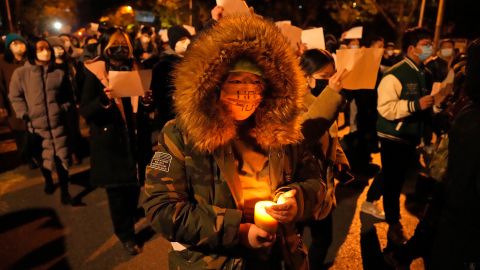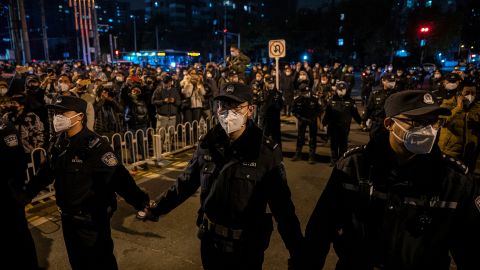Beijing
CNN
—
From Shanghai to Beijing, protests have erupted across China in a rare show of dissent against the ruling Communist Party sparked by anger over the country’s increasingly costly zero-Covid policy.
As numbers swelled at demonstrations in multiple major cities over the weekend, so too have the range of grievances voiced – with some calling for greater democracy and freedom.
Among the thousands of protesters, hundreds have even called for the removal of Chinese leader Xi Jinping, who for nearly three years has overseen a strategy of mass-testing, brute-force lockdowns, enforced quarantine and digital tracking that has come at a devastating human and economic cost.
Here’s what we know.
The protests were triggered by a deadly fire last Thursday in Urumqi, the capital of the far western region of Xinjiang. The blaze killed at least 10 people and injured nine in an apartment building – leading to public fury after videos of the incident appeared to show lockdown measures had delayed firefighters from reaching the victims.
The city had been under lockdown for more than 100 days, with residents unable to leave the region and many forced to stay home.
Videos showed Urumqi residents marching to a government building and chanting for the end of lockdown on Friday. The following morning, the local government said it would lift the lockdown in stages – but did not provide a clear time frame or address the protests.
That failed to quell public anger and very quickly, the protests spread beyond Xinjiang, with residents in cities and universities across China also taking to the streets.
The most prominent protests took place in two of China’s biggest cities – the capital Beijing and financial center Shanghai.
In Shanghai on Saturday, hundreds gathered for a candlelight vigil on Urumqi Road, named after the Xinjiang city, to mourn the fire victims. Many held up blank sheets of white paper – a symbolic protest against censorship – and chanted, “Need human rights, need freedom.”
Some also shouted for Xi to “step down,” and sang The Internationale, a socialist anthem used as a call to action in demonstrations worldwide for more than a century. It was also used during pro-democracy protests in Tiananmen Square in Beijing before a brutal crackdown by armed troops in 1989.
China’s zero-Covid policies have been felt particularly acutely in Shanghai, where a two-month long lockdown earlier this year left many without access to food, medical care or other basic supplies – sowing deep public resentment.
By Sunday evening, mass demonstrations had spread to Beijing, Chengdu, Guangzhou and Wuhan, where thousands of residents called for not only an end to Covid restrictions, but more remarkably, political freedoms. Residents in some locked-down neighborhoods tore down barriers and took to the streets.
Protests also took place on campuses, including the prestigious institutions of Peking University and Tsinghua University in Beijing, and Communication University of China, Nanjing.
Public protest is exceedingly rare in China, where the Communist Party has tightened its grip on all aspects of life, launched a sweeping crackdown on dissent, wiped out much of civil society and built a high-tech surveillance state.
The mass surveillance system is even more stringent in Xinjiang, where the Chinese government is accused of detaining up to 2 million Uyghurs and other ethnic minorities in camps where former detainees have alleged they were physically and sexually abused.
A damning United Nations report in September described the region’s “invasive” surveillance network, with police databases containing hundreds of thousands of files with biometric data such as facial and eyeball scans.
China has repeatedly denied accusations of human rights abuses in the region.

While protests do occur in China, they rarely happen on this scale, nor take such direct aim at the central government and the nation’s leader, said Maria Repnikova, an associate professor at Georgia State University who studies Chinese politics and media.
“This is a different type of protest from the more localized protests we have seen recurring over the past two decades that tend to focus their claims and demands on local officials and on very targeted societal and economic issues,” she said. Instead, this time the protests have expanded to include “the sharper expression of political grievances alongside with concerns about Covid-19 lockdowns.”
There have been growing signs in recent months that the public has run out of patience with zero-Covid, after nearly three years of economic hardship and disruption to daily life.
Isolated pockets of protest broke out October, with anti-zero-Covid slogans appearing on the walls of public bathrooms and in various Chinese cities, inspired by a banner hung by a lone protester on an overpass in Beijing just days before Xi cemented a third term in power.
Earlier in November, larger protests took place in Guangzhou, with residents defying lockdown orders to topple barriers and cheer as they took to the streets.
The Shanghai protests on Saturday led to scuffles between demonstrators and police, with arrests made in the early hours of the morning. Undeterred, protesters returned on Sunday, where they met a more aggressive response – videos show chaotic scenes of police pushing, dragging, and beating protesters.
At one point, hundreds of police officers formed a human wall to block off major roads, with a loudspeaker blaring a message for protesters to leave.
The videos have since been scrubbed from the Chinese internet by censors.

Some protests in other parts of China appear to have dispersed peacefully.
In several university campuses, students described seeing security guards covering up protest signs with jackets and black paint. One video shows a university official warning the students they would “pay for what you did today.”
On Sunday, Beijing’s municipal government banned blocking entrances to residential compounds under lockdown, saying they must remain clear for emergency services.
The central government has yet to respond to the protests. CNN has reached out to the Ministry of Foreign Affairs for comment.
State-run media has also stayed silent on the demonstrations – but doubled down on zero-Covid, with one newspaper on Sunday calling it “the most scientifically effective” approach.